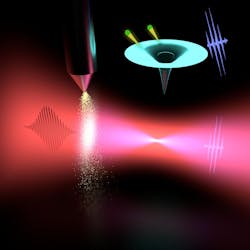More compact XUV lasers may benefit a myriad of research
A new technique is aiding in the generation of more intense extreme-ultraviolet (XUV) pulses, which could overcome existing laser stability limitations, and also enhance research in areas such as imaging and spectroscopy.
Developed by a team led by the Max Born Institute (Berlin, Germany), the new method is based on high harmonic generation (HHG), which relies on focusing a near-infrared (near-IR) laser pulse into a gas target. Very short light bursts with frequencies that are harmonics of the near-IR driving laser are emitted—these are typically found in the XUV region. According to the researchers, to obtain intense XUV pulses, as much XUV light as possible must be generated, something that can be achieved in the production of a very large focus of the near-IR driving laser in a large laboratory.
In their study, the team—which also included researchers from ELI-ALPS (Szeged, Hungary) and the Institutul Național de Cercetare-Dezvoltare pentru Tehnologii Izotopice și Moleculare (INCDTIM; Cluj-Napoca, Romania)—was able to shrink an intense XUV laser by using a setup that extended over a length of only 2 m.1 Specifically, instead of generating XUV light at the focus of the near-IR driving laser, the researchers placed “a very dense jet of atoms” relatively far away from the near-IR laser focus.
Advantages
The researchers note two significant advantages to their new technique: As the near-IR beam at the position of the jet is large, many XUV photons are generated. Also, the XUV beam generated is large, with a large divergence, allowing it to be focused to a small spot size. “The large number of XUV photons in combination with the small XUV spot size,” the researchers say, “makes it possible to generate intense XUV laser pulses.”
Shrinking the laser system could better aid in scientific, industrial, and medical applications, as those benefit from the availability of compact lasers in the visible range of the electromagnetic spectrum. According to the researchers, this is different at XUV wavelengths, “where very large facilities (so-called free-electron lasers) have been built to generate intense XUV pulses.”
Via multiphoton ionization of argon atoms, the study demonstrated the high intensity of XUV pulses (see figure). The atoms could then be multiplied and ionized, which the researchers note has led to ion charge states of Ar2+ and Ar3+. This requires the absorption of at least two and four XUV photons, respectively. According to the researchers, regardless of the small footprint of this intense XUV source, “the obtained XUV intensity of 2 × 1014 W/cm2 exceeds that of many already existing intense XUV sources.”
The newly developed compact, intense XUV laser and methods could be implemented in the lab, enhancing a variety of research, including attosecond-pump, attosecond-probe spectroscopy (existing techniques have made that extremely difficult, according to researchers). Other application areas that could benefit include imaging of nanoscale objects such as biomolecules.
REFERENCE
1. B. Major et al., Optica, 8, 960–965 (2021); https://doi.org/10.1364/optica.421564.

Justine Murphy | Multimedia Director, Digital Infrastructure
Justine Murphy is the multimedia director for Endeavor Business Media's Digital Infrastructure Group. She is a multiple award-winning writer and editor with more 20 years of experience in newspaper publishing as well as public relations, marketing, and communications. For nearly 10 years, she has covered all facets of the optics and photonics industry as an editor, writer, web news anchor, and podcast host for an internationally reaching magazine publishing company. Her work has earned accolades from the New England Press Association as well as the SIIA/Jesse H. Neal Awards. She received a B.A. from the Massachusetts College of Liberal Arts.
